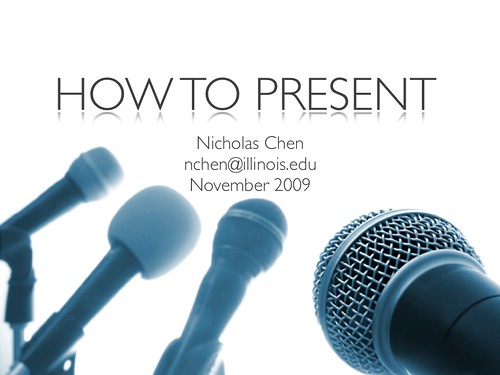How To Present

I gave a talk on "How to Present" a couple of weeks ago as part of the Grad Academic Council at the University of Illinois. Here's the abstract:
Making The World A Better Place, One Presentation At A Time
You've been to your fair share of presentations; some of them were wonderful, some were pedestrian and some were just awful. Sooner or later you will have to give your own presentation, hopefully one that you and your audience will feel good about. So, what can you do to give your best presentation each time?
In this session, I'll discuss general guidelines on what to do before, during and after the presentation. And I'll illustrate my points by giving real examples (sources anonymized, of course, to protect the innocent) of mistakes that all of us have made from time to time. I'll also focus on specific techniques for CS presentations because we are a different breed of presenters with all our graphs, source code and UML diagrams.
If you are going to be making a major presentation for the first time, stop by to pick up some new techniques. And if you are a seasoned presenter, stop by to see if I've made any faux pas in my own presentation.
Here's the PDF version of the slides; and here's the Keynote version (you need to rename the file from to HowToPresent.zip to HowToPresent.key; if you use a browser that automatically unzips the file into a folder, just rename the folder from HowToPresent to HowToPresent.key). The slides are released under the Creative Commons Attribution 3.0 license. The pictures on the slides are from iStockphoto.com and I ask that you don't copy-and-paste them from the slides but purchase you own copies of them to support the artists.
The presentation was recorded and you can watch it here. The high-speed version shows me as I present (in addition to the slides) so you can see the gestures that I am making - my gestures help illustrate the points that I make.
I learned a lot from giving this presentation. And I definitely see plenty of ways to improve the next time I give it. The only way to get better at presenting is to practice by giving more presentations! And, of course, by listening to your audience. So, I value any feedback that you have. Please send them to me at nchen_AT_illinois.edu.
If you are watching the video, my presentation itself ended at around 40 minutes. After that I was taking questions but I forgot to repeat those questions into the microphone so you can't hear them in the video. I have summarized the important points for you below:
- Roy Campbell mentioned how for certain job talks, the audience expect to see at least one equation on your slides. On my slides, I said that equations should be avoided unless really necessary. The case that Roy mentioned is an example of an exception. Again, it's all about what your audience expects. So do some investigation first on the expectation of the audience before preparing your slides.
- The person sitting beside Roy made a comment about how much you should have on the slides. In the extreme case, you really don't want to have anything – that way, everyone's attention would be on you. However, for most CS presentations, it really helps to have some diagram/text. It's much easier to describe a system with UML diagrams. Additionally, sometimes you want filler images on your slides – these actually pique your audience's interest from time to time so that they don't get too bored with what you are saying.
- Danny made a comment about making sure that the last slide that you leave on the screen is the conclusion slide which summarizes your ideas. You should leave this slide on the screen even if you are taking questions (as opposed to have a slide with the word "Questions?" on it). This gives anyone who comes in late the opportunity to at least see a summary of your work.
- Danny also made an interesting comment about how you should use the first slide to introduce yourself – introduce where you are from, what's your background, etc. This gives the audience the ability to build some rapport with you. And more importantly, it gives them the chance to familiarize themselves with your accent and style before going into the technical parts of the presentation.
- One person at the back made a very important comment about displaying graphs: you need to mention the units that you are using on the axes. This gives the audience an idea on what the data actually means.
comments powered by Disqus